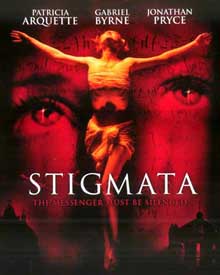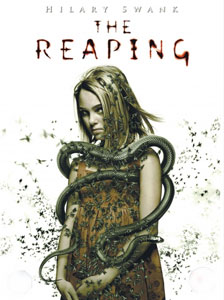 A surprisingly good cast makes the mystically Christian-themed horror film The Reaping (2007) a lot better than I was expecting.
A surprisingly good cast makes the mystically Christian-themed horror film The Reaping (2007) a lot better than I was expecting.
Hilary Swank plays Katherine Winter, a scholar & ex-minister who lost her faith when her child & husband were killed in the Sudan as sacrifices to God.
She now travels the world debunking religious miracles, revealing the science that underlays every appearance of the supernatural, then lecturing on her findings with the specific intent to encourage atheism.
Her assistant Ben (Idris Elba) on the other hand is an ex-gangbanger who became a man of faith. He is always holding out hope that something somewhere will be a real miracle, whether of God or the Devil.
Katherine arrives in the isolated town of Haven, ready to debunk a few more miracles, starting with a plague of blood which has occurred in the Bible belt community. That uneducated community is awaiting all the other biblical plagues to follow. Worse, they're blaming a twelve year old little girl, Laura McConnell (Anna-Sophia Robb) who has them all up in arms for a witch-burning.
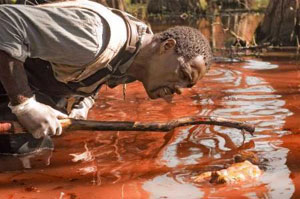 Sure enough, the swamp-water really had turned to blood (not very convincingly I'm afraid), a seeming miracle followed by a rain of toads (rubber toads if you look too close). Sure enough, the swamp-water really had turned to blood (not very convincingly I'm afraid), a seeming miracle followed by a rain of toads (rubber toads if you look too close).
Then comes a plague of flies, then the death of livestock. Fifth is the plague of headlice & sixth is boils. Seventh will be locusts, which will be the first kind of cool one.
Father Costigan (Stephen Rea) is a weirdo priest who is a pretty radical believer in the Devil. He experiences visions & minor miracles & has seemingly lost his mind. This is a great side-character & too bad he didn't have more to do within the story.
The tale kind of lost me for a while, when the crazed priest turns out to be right & the Bible belt loonies are right & the little girl really is a manifestation of Satan with hideous satanic cultists converted to her worship. For quite a stretch of the film the idea of witch-burning seems really to be promoted as the right thing to do.
So the devil-child stands among the locusts as hillbilly Christians prepare to gun her down. But the locusts protect her.
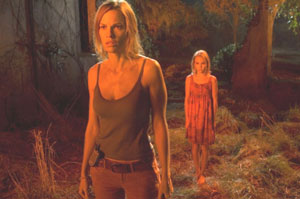 Only Katherine has the power to kill the little girl, she whose own little girl was killed due to just such superstitious malice. She that promoted reason & skepticism did so at risk of her very soul. This is to be her redemption. Only Katherine has the power to kill the little girl, she whose own little girl was killed due to just such superstitious malice. She that promoted reason & skepticism did so at risk of her very soul. This is to be her redemption.
The film very nearly goes all to pieces as a work by Christ-cult crackpots. The story suddenly reveals -- without laying any foundation for it -- that hundreds, thousands of children had already been sacrificed to the Devil, though no one locally had ever noticed any missing kids.
Katherine's assistant Ben gets killed merely because that's what token black guys are for in horror films. Katherine goes after the evil child as the plagues of darkness & of fire permit some idiotic special FX. The film is getting worse & worse with the phony FX & cliches, even tossing in the lamest of love interests (David Morrissey).
There is however a redeeming twist in the story, as unexpected irony rises its head & in retrospect all the weaknesses of the story seem pretty right. I won't reveal it, as it would be too great a spoiler. But easily insulted Christians sure won't like it.
While nowhere near a great movie, this is decent piece of shlock, with a serious streak to it. I actually like mystically inclined "the devil is real" films, & this one creates some edgy stuff about whether it is good or evil that Christians frequently set out to cause great harm to anyone who doesn't share their worldview.
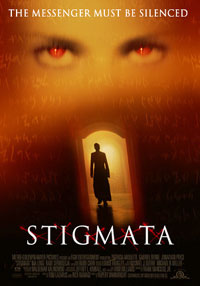 When Stigmata (1999) was in the theaters, the local reviewer gave it ten thumbs down & an NPR critic trashed it wholeheartedly.
When Stigmata (1999) was in the theaters, the local reviewer gave it ten thumbs down & an NPR critic trashed it wholeheartedly.
But I liked it. Not because it was any good, but because it was moody & the actors, struggling valiently to make the confused script convincing, played each scene with dour seriousness that was thoroughly arresting.
Gabrielle Byrne is a scientifically minded ex-priest who works for the Vatican debunking miracles. He has been sent to investigate a case of the Stigmata which of course turns out to be a true supernatural phenomenon.
Byrne as the priest-scientist & the Patricia Arquette as the woman afflicted by stigmata & demonic visitations each turn in performances well above the average for horror films. Can't pick on it for bad acting.
It has some dufus moments like when Arquette goes running through the streets of the city with cars crashing all around her. It's just the dumbest excuse for a car crash scene yet & had nothing to do with the story.
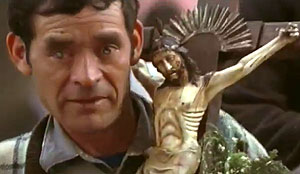 Another fast-moving-cars scene (when she's running across the street to save the nonexistent baby) reminded me of the same scene in the Eddy Murphy film Bowfinger (1999) wherein it is supposed to be funny when a director says "In this scene you run in front of traffic." Another fast-moving-cars scene (when she's running across the street to save the nonexistent baby) reminded me of the same scene in the Eddy Murphy film Bowfinger (1999) wherein it is supposed to be funny when a director says "In this scene you run in front of traffic."
In Stigmata that's supposed to be scary or intense when it's really just as silly as the Steve Martin Eddy Murphy parody of just such scenes makes it.
Then there's the treatment of celibate Byrne as a "romantic lead" imposing on the characters a love story never the least bit believable. There's nothing sexy about the possession yet when Arquette is at her craziest demonic, Byrne is having heart palpitations of desire. Imagine if Max von Sydow in The Exorcist had responded to the possessed girl puking green pea soup with "Man, she's sexy!" as that seems to be Byrne's response even to the possessed woman's grosser moments.
But such dumbass sequences are few compared to the number of effective scenes. The first stigmatic attack made me jump out of my seat. No wussy "wounds of Christ" sequence this, it's as gruelling as it probably really would be to have big fat nails hammered through your arms. Then there's the floating-above-the-bed sequence ripped off from The Exorcist but adds a new on-the-cross "posture" that was attractively creepy. So for the sequences of bloody violent supernatural affliction, this is a convincing film.
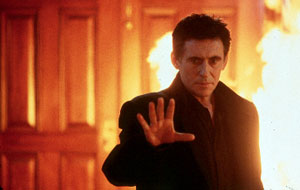 The idea that stigmatic possession & demon possession are the same was also a complicated genuinely mystical idea that is rarely treated cinematically, because in the simplistic language of cinema good & evil are usually kept separate. The idea that stigmatic possession & demon possession are the same was also a complicated genuinely mystical idea that is rarely treated cinematically, because in the simplistic language of cinema good & evil are usually kept separate.
There is a saintly ingredient to the woman's stigmatic suffering, & to the stigmatic priest whose ghost has become a messenger of Christ through her. But it is nevertheless very demonic in expression; & the priest's explanations, that the closer one comes to God the more susceptible one is to the experience of suffering & evil, is theologically sound in mystic circles.
Underlying the phenonema is the demon-spirit-priest-stigmatic is a secret Aramaic scripture written purportedly by the hand of Jesus which states (rather innocuously it seemed to me) that the Church is within each human & is not a building of wood or mortar & stone. The Catholic hierarchy apparently believes that if the true words of Jesus became known the Catholic church would come crashing to an end because the church requires wealth & cathedrals & authorities, & could not survive the notion that each worshipper is a church.
So the film embraces a time-honored paranoia about the Catholic church being run by men who know the church is a fraud & who would murder innocent people in order to insure that Truth remained bury in dark library lock-downs under the Vatican, that even priests & saints would be killed to keep the authentic words of Jesus from becoming known.
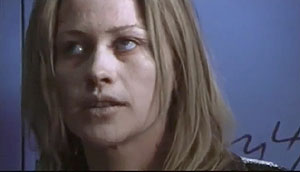 I suspect one has to have been abused within a Christian tradition to delight in this kind of plot-thread. Since I was not raised Christian I kept looking for a logical reason for the irrational behavior this film imposes on Catholic authority, & there was none. I suspect one has to have been abused within a Christian tradition to delight in this kind of plot-thread. Since I was not raised Christian I kept looking for a logical reason for the irrational behavior this film imposes on Catholic authority, & there was none.
Now & then the film is effectively dark & spooky. While the story unfolds -- before the viewer knows it is only going to add up to noise & thunder without much sense to it all -- it can feel very strange & captivating.
But it finally leaves one with the sense that the script was little more than some ex-Catholic's hostility being worked out with priests indistinguishable from the Mafia, the Vatican hating knowledge, priests eager to murder to protect its policies of keeping knowledge of the true Christ from reaching the despised Catholic plebes.
I was willing to suspend disbelieve to go along with the idea that the institution of the Church is evil to the core, but I never felt anything in this story got beyond the the level of the pissy ranting of some dork who once got his knuckles rapped by a nun. When the film finally ends in a computer-animated conflagration, it all has a feeling of having stopped mid-story without any actual point or convincing climax having been achieved.
There are several confused bits in the film that I'd've changed had anyone bothered to send me the script to make a few needed corrections beforehand. But overall it's a good addition to the religious-horror genre birthed by The Exorcist. No one should miss this film who loves middlingly good horror, but viewers who can live with or without a horror film -- this one wouldn't be the exception for them.
copyright © by Paghat the Ratgirl
|
